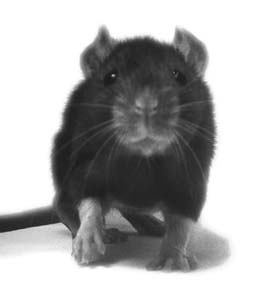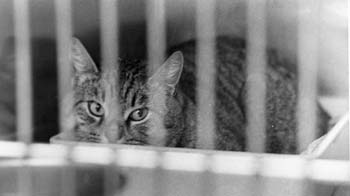![[Metroactive News&Issues]](/gifs/news468.gif)
[ San Jose | Metroactive Central | Archives ]
 Winners, Not Dinners Some species thrive in the urban jungle By Jim Rendon FROM THE MURKY past of my science education, I seem to remember an old physics adage: For every action there is an equal and opposite reaction. As it is with physics, so it is with biology, sort of. There's plenty of reaction; the problem is, it is not what most people would call equal. As fascinating, unique creatures fall to the loss of habitat or the jaws of a more aggressive imported species, they are replaced. Unfortunately, it tends to be species like seagulls, pigeons, raccoons and feral cats that show up in their place. The key to survival in the era of unchecked development is flexibility, says Joy Anderson, a biologist with the San Francisco Bay Wildlife Refuge. Flexibility in diet and habitat needs makes a species much more likely to be able to survive in the haphazard mess that people leave behind. It also helps to be from out of town. New species often overcome native species that have no defenses against the invader. Along with Larry Ellison, Pierre Omidyar and John Chambers, this valley's winners include some of the following wonders of nature that are steadily gaining a foothold over our more fragile natives. Star Thistle It spreads out across the ground like an inverted octopus, growing tall meandering stalks. But these tentacles are topped with flowers surrounded by long sharp spikes. It grabs at bare legs and clothing. Once the plant matures, even cattle, which have been known to chow down on reconstituted cardboard, are unable to eat it. The plant first came to California from Afghanistan as filler in sacks of alfalfa seed. Most of the plant has remained west of the Sierra Nevada, but in this state it is everywhere and growing fast. Pulling it or mowing it only makes the plant spread faster. Star thistle is such a threat that it has actually brought environmentalists, farmers and ranchers together, hoping to study the plant so they can develop a strategy to combat it.
Feral Cats Packs of flea-bitten, bony-thin cats can be seen at just about any overflowing dumpster. They're the descendants of someone's own Fluffy, the fat and sassy domesti-cat that lounges on a window seat in the sun, lifting a paw for no one. Their wild cousins, however, know little of domestic bliss. They survive on the little trash they can dig up and on what they can kill, which is often not enough to survive on--real survival skills were bred out of the species long ago. Nonetheless, the hunting they do can cause a lot of harm. They have been a disaster for the salt marsh harvest mouse, the red-legged frog and other rare species farther down the food chain. And they breed like rabbits. A pair of breeding cats can have two litters a year of five or more kittens, which themselves start reproducing in less than a year. According to the Feral Cat Coalition, a San Diego-based organization that traps and neuters feral cats, in a seven-year span two original breeders can be responsible for 420,000 offspring, assuming all the kittens survive and breed. Norway Rat The critter that gave Europe the bubonic plague is now thriving here in the valley. The Norway rat, usually a one-pounder more than a foot long, is a sort of superhero rodent. It can swim for three days straight. It can dive, staying underwater for half a minute at a time. It can chew through concrete, sheetrock, cables, just about anything, given enough time and motivation. And it will eat all manner of things, from bird eggs to heaps of garbage. The rats have become a problem species at the San Francisco Bay Wildlife Refuge, says Albertson. Rats from the nearby landfill often make their way into the salt marsh, gobbling up clapper rail eggs. In 1997 the county received 1,467 rat complaints from residents, and it spends $2 million a year to combat the valley's rat population. Red Fox Though they look cute and have an aristocratic air about them, red fox are big troublemakers. They almost single-handedly destroyed the clapper rail population in the South Bay. Red fox are not from here. They were imported to California from the East Coast for fur production. Inevitably, some escaped into the wild. Now biologists estimate that there are thousands of them throughout the state. Unlike the native gray fox, which is a woodland species that rarely comes out into the open, the red fox is hardly shy. It has severely impacted populations of terns, gulls, herons, egrets and stilts. In response to the plummeting rail population, officials at the refuge trap and destroy about 90 red fox every year, which has given the clapper rail a fighting chance.
Pigeons Winged rats, quarter-pound cockroaches--pigeons get a bad rap. While there's no available estimate on their true numbers, they are thriving and almost everywhere. They also tend to wear the rigors of life on the street in bold relief. Most are missing a few toes, a foot, an eye. Some are so slow, they get run over by cars--and this doesn't seem to happen much to other birds. But pigeons are essentially harmless. Though much has been made of their germy droppings, the transmission of diseases to humans is so rare that some advocates argue it simply doesn't happen at all; it's merely hysteria. Like people, pigeons seek out the good life. Why rough it in the woods when a sunny ledge under a cornice will do? Why hunt for food when any pigeon worth its feathers can get its fill at a good perch near a park bench? Pigeons go where people go, and eat what we throw away. And sometimes they provide food for feral cats and the occasional raptor passing through the urban jungle. [ San Jose | Metroactive Central | Archives ]
|
From the November 24-December 1, 1999 issue of Metro, Silicon Valley's Weekly Newspaper.
Copyright © 1999 Metro Publishing Inc. Metroactive is affiliated with the Boulevards Network.
For more information about the San Jose/Silicon Valley area, visit sanjose.com.

